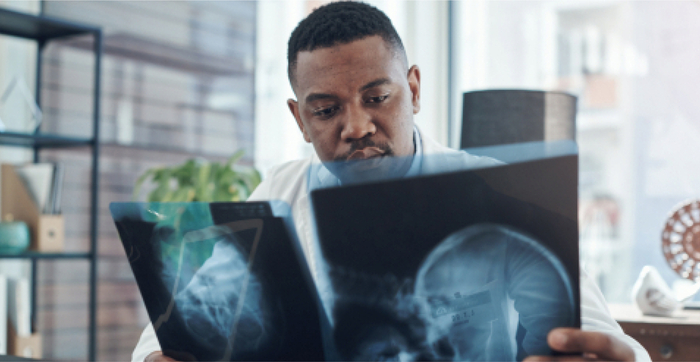
Feel better faster. Get care today.
From the clinic or your couch. Find high quality, same-day urgent care for you and your kids. Book an urgent care visit today.

Yes, if the urgent care location you are visiting has imaging services, they may be able to do an x-ray to see if you have a broken bone. There are exceptions to this, so continue reading to find out when you should consider going togo to an urgent care vs emergency room for a broken bone.

From the clinic or your couch. Find high quality, same-day urgent care for you and your kids. Book an urgent care visit today.
When you experience an injury, it can be difficult to know whether you should go to the emergency room or to an urgent care clinic. While both options can provide you with medical attention, there are significant differences between the two.
According to debt.org, tThe biggest difference is that urgent care clinics are designed to treat non-life-threatening conditions, while emergency rooms are equipped to handle life-threatening emergencies.
For a possible broken bone, choosing between urgent care and the emergency room depends on several factors.
While the emergency room can provide more comprehensive care for severe injuries, it can also be more costly and time-consuming—something that most people prefer to avoid if possible, notes Debt.org.
Since most urgent care clinics offer X-rays, they are a convenient and cost-effective option for diagnosing and treating broken bones. Additionally, most urgent care centers are open seven days a week, making them an accessible immediate care option.
While urgent care is a great option in most cases, there are some types of broken bones that require emergency room care (such as compound or “open” fractures), according to the American Academy of Orthopaedic Surgeons (AAOS). In a nutshell, if there is an open wound near the suspected fracture site, it should be assumed to be an open fracture requiring emergency care.
Assuming you are seeking care for a possible simple (closed) fracture, going to an urgent care clinic is a faster and more cost-effective way to get evaluated and treated. The first step you’ll encounter is the check-in process.
When you arrive at an urgent care facility, you will need to check in at the front desk. You can try to avoid wait times by using an urgent care app like Solv, which helps you book your appointment ahead of time. You will be asked to provide your personal information and insurance details if you have insurance. If you don't have insurance, most urgent care clinics will require a payment or payment plan.
After checking in, you will be examined by a healthcare professional. They will ask you questions about your injury, perform a physical examination, and if necessary, also order an X-ray to diagnose the extent of your injury.
Usually, an X-ray is needed to diagnose a broken bone (also known as a fracture). Stanford Medicine outlines the process of getting an X-ray in the following steps:
Getting an X-ray is quick and painless, however, you will be asked to remain still while the X-ray is taken. After getting your X-ray done, the images will be reviewed by a radiologist or physician to determine the extent of your injury.
If you have suffered an injury to your musculoskeletal system it is essential to get an accurate diagnosis to ensure proper treatment, notes Stanford Health. X-rays are commonly used to diagnose broken bones, as well as complications with the lungs, and other conditions. X-rays are performed in many medical facilities, including emergency rooms, imaging centers, clinics, and urgent care centers.
Before we dive into when an X-ray may be needed, it is important to understand some medical terminology related to bones.
A fracture is the medical term for a broken bone, according to Johns Hopkins. A fracture can be open (called a “compound fracture”) or closed (called a “simple fracture”).
A dislocation occurs when a bone is displaced from its normal position, according to the National Library of Medicine. This commonly happens at a joint where two bones meet (such as a knee, hip, or shoulder).
Sprains happen when ligaments are stretched or torn, according to the Mayo Clinic. This is common in the ankle area and is usually the result of a joint being forced into an unnatural movement.
There are 206 bones in the average adult human body, and some of the most commonly broken bones, according to the Cleveland Clinic, include:
A broken bone usually occurs after either a blunt force (such as an accident or fall), or stress (such as a crush accident or osteoporosis). The symptoms of a broken bone, according to the Cleveland Clinic, include:
X-rays were invented in 1895 and have since become an excellent way to diagnose many things, including broken bones. Early detection and treatment can help prevent further damage to the bones and surrounding tissues, as well as prevent complications associated with a broken bone (such as muscle damage, blood loss, and nerve damage). Fast diagnosing and treatment is also linked to a faster recovery time, according to the Mayo Clinic.
Whether you visit an urgent care center or emergency room for a potential broken bone, one of the first things the medical staff will do is take an X-ray. This will provide them with a clear image of the bone and help them determine the extent of the injury. The X-ray results will also guide the treatment options available to you.
The X-ray results will show whether the bone is broken, how severe the break is, and where exactly the break is located, according to the AAOS. Based on this information, the medical staff will be able to determine the best course of action for treatment.
After the medical staff has determined the extent of the injury through examination and X-ray, they will provide you with pain management options. This may include over-the-counter pain relievers or prescription medication, depending on the severity of the injury, as well as your medical history, allergies, and other medications.
Depending on the severity of the break, rehabilitation, and recovery options may be necessary. This may include physical therapy, occupational therapy, or surgery. The medical staff will work with you to create a rehabilitation and recovery plan that is tailored to your specific needs and may involve orthopedic specialists.
The treatment options available to you will depend on your X-ray findings, according to the AAOS. If the break is minor, you may only need a cast or splint. If the break is more severe, surgery may be necessary. The medical staff will work with you and consult specialists to determine the best treatment option for your specific injury.
When it comes to getting X-rays for broken bones, urgent care facilities offer several benefits over emergency room visits. Some of the biggest benefits include lower costs and convenience compared to emergency room visits. Here is more on the benefits of urgent care, according to Debt.org.
Urgent care facilities are typically open longer hours and on weekends, making it easier for you to get the care you need without having to take time off work or wait until your primary care physician is available. Additionally, many urgent care facilities aim to have convenient locations—such as near shopping centers or downtown districts.
Urgent care facilities are generally less expensive than emergency rooms, making them a more cost-effective option for X-rays and other non-life-threatening medical needs. According to Debt.org, the cost of an emergency room visit can be 5 to 10 times higher than the cost of an urgent care visit.
Most insurance plans cover urgent care visits and X-rays. This helps make urgent care visits an even more affordable option for many people. Additionally, urgent care facilities often have payment options for those who are uninsured.
When it comes to broken bones, the severity of the injury will dictate the need for advanced imaging or a referral to a specialist. Urgent care centers are staffed with healthcare providers who are trained to handle minor injuries, but they may not have the equipment or expertise to diagnose and treat complex or life-threatening fractures, notes Debt.org.
For example, if you have a compound (open) fracture or a fracture that requires surgery, urgent care may not be equipped to provide the care you need. In these cases, you may need to be referred to an emergency department or specialist for further evaluation and treatment.
Factors that may affect the decision to seek specialized care, according to Debt.org include:
When it comes to getting medical attention for broken bones, it is important to consider whether an urgent care or emergency room will be the best option for you. The convenience and cost-effectiveness of going to an urgent care facility is a great choice for most cases of simple fractures. However, an emergency room is best for complex fractures. Important points to remember if you are going to urgent care for a broken bone, according to Debt.org, is:
Delaying treatment can result in further damage and complications, according to the Cleveland Clinic. Some of these complications include:
It is important to remember that not all broken bones are obvious. Any symptom of a broken bone should be evaluated by a medical professional. Urgent care facilities can help you by performing an x-ray and providing immediate treatment options for minor fractures.
Yes, urgent care clinics can provide X-rays for broken bones if they have imaging services.
You should go to the emergency room for a broken bone if you have an open fracture or a severe injury that an urgent care clinic may not be equipped to handle.
Urgent care clinics are generally more cost-effective and convenient than emergency rooms. They offer longer hours, weekend availability, and are usually located in convenient areas.
Urgent care clinics may not have the equipment or expertise to diagnose and treat complex or life-threatening fractures. In such cases, you may need to be referred to an emergency department or specialist.
Yes, most insurance plans cover urgent care visits and X-rays. Urgent care facilities often have payment options for those who are uninsured.
Urgent care facilities offer several benefits for X-rays, including lower costs, convenience, longer operating hours, and accessibility. They are generally less expensive than emergency rooms and most insurance plans cover urgent care visits and X-rays.
Urgent care centers may not have the equipment or expertise to diagnose and treat complex or life-threatening fractures. If you have a compound fracture or a fracture that requires surgery, you may need to be referred to an emergency department or specialist.
Delaying treatment for a broken bone can result in further damage and complications, including soft tissue damage, muscle damage, nerve damage, further breaking of the bone, and internal or external bleeding. Not all broken bones are obvious, so any symptoms should be evaluated by a medical professional.